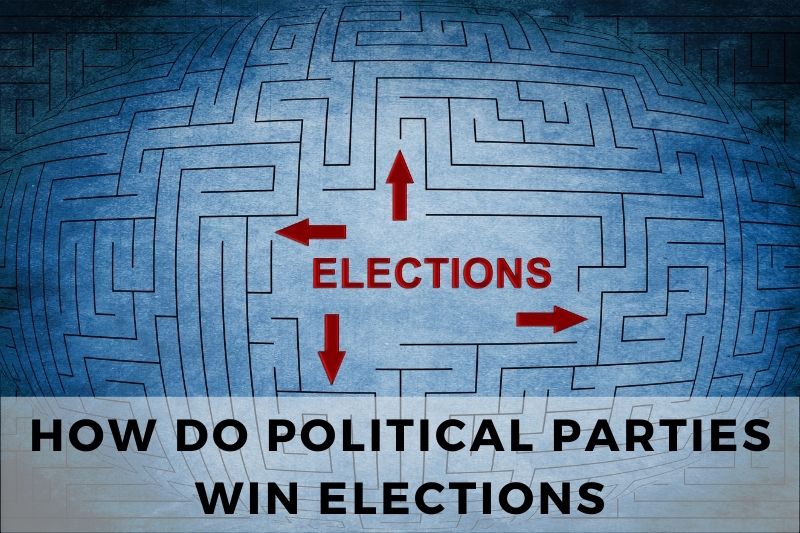
Political parties, the backbone of democratic systems, are constantly engaged in the battle for electoral victory. Winning elections isn’t a stroke of luck; it’s a strategic endeavor rooted in a variety of well-honed tactics. From ground operations to media management, fundraising to crisis mitigation, the path to victory is paved with deliberate choices and calculated moves.
In this article, we’ll delve into the common strategies employed by political parties to secure electoral success. Whether you’re a political novice or a seasoned observer, understanding these tactics sheds light on the intricate dynamics of modern political campaigns.
Let’s explore how political parties navigate the terrain of electoral competition with wit, wisdom, and a dash of humor.
How Do Political Parties Win Elections – Common Strategies That Work
#1. Building Strong Ground Game
A robust ground game is essential for any political party aiming for victory. This involves establishing a strong network of volunteers and staffers to engage with voters directly. Door-to-door canvassing, phone banking, and organizing local events are key components of a successful ground game. By establishing a presence in communities and fostering personal connections with voters, parties can sway undecided individuals and mobilize their supporters effectively.
#2. Crafting Compelling Party Platform
A compelling party platform serves as the foundation of a successful election campaign. It articulates the party’s values, priorities, and policy proposals in a clear and persuasive manner. A well-crafted platform resonates with voters by addressing their concerns and offering viable solutions to pressing issues. Parties often conduct extensive research and consult with experts to develop platforms that appeal to a broad spectrum of the electorate.
#3. Effective Media Management
In today’s media-saturated landscape, effective media management is crucial for political success. Parties must carefully manage their public image through strategic messaging and media relations. This involves leveraging traditional media outlets, such as newspapers and television, as well as digital platforms like social media. By controlling the narrative and responding swiftly to media inquiries and controversies, parties can shape public perception and maintain momentum throughout the campaign.
#4. Strategic Fundraising
Financing a modern election campaign requires substantial resources, making strategic fundraising a top priority for political parties. Political parties raise money in a variety of ways. This includes individual donations, corporate contributions, and fundraising events, to fuel their operations. Successful fundraising efforts not only provide the financial means to sustain a campaign but also signal viability and support to voters, donors, and the media.
#5. Tailored Campaign Communication
Effective communication is at the heart of any successful election campaign. Parties must tailor their messaging to resonate with different demographics and target audiences. This involves utilizing a variety of communication channels, from traditional political advertisements to digital content and interpersonal communication. By understanding the concerns and preferences of various voter groups, parties can craft messages that are compelling, relatable, and persuasive.
#6. Coalition Building
Coalition building is a strategic tactic employed by political parties to broaden their support base and increase their chances of electoral success. This involves forming alliances with other political parties, interest groups, and community organizations that share similar goals or ideologies. By pooling resources and coordinating campaign efforts, parties can amplify their message and mobilize a larger voter coalition. Successful coalition building requires negotiation, compromise, and the ability to navigate diverse interests while maintaining core principles.
#7. Get-Out-the-Vote (GOTV) Efforts
Get-Out-the-Vote (GOTV) efforts are instrumental in translating voter support into actual votes on election day. Political parties deploy various tactics to encourage voter turnout, including door-knocking, phone calls, and targeted messaging. Volunteer mobilization, voter education campaigns, and early voting initiatives also play a crucial role in GOTV efforts. By identifying and energizing their supporters, parties can maximize their electoral strength and secure victory in closely contested races.
#8. Digital Outreach
In the digital age, political parties must harness the power of technology to reach voters where they are – online. Digital outreach encompasses a wide range of tactics, including social media advertising, email campaigns, and targeted digital content. Parties leverage data analytics and digital tools to micro-target specific voter demographics and tailor their messaging accordingly. Building an engaging online presence allows parties to influence voters, solicit donations, and mobilize support in real-time, shaping the narrative of the campaign in the digital realm.
#9. Candidate Selection
The selection of candidates is a critical decision for political parties, as it directly impacts their electoral prospects. Parties carefully vet and recruit candidates who possess the requisite qualifications, charisma, and electability to represent their interests effectively. Factors such as name recognition, incumbency status, and demographic representation are taken into consideration during the candidate selection process. By fielding strong and relatable candidates, parties can inspire confidence among voters and enhance their chances of electoral success.
#10. Crisis Management
In the unpredictable landscape of electoral politics, crises are bound to arise – from scandals and controversies to unexpected setbacks. Effective crisis management is essential for political parties to mitigate damage to their reputation and maintain public trust. Parties must respond swiftly and decisively to crises, employing crisis communication strategies to address concerns, provide transparency, and demonstrate accountability. By navigating crises with integrity and resilience, parties can minimize the impact on their electoral prospects and emerge stronger in the eyes of voters.
Closing Thoughts
In the dynamic arena of electoral politics, success is not guaranteed, but it is attainable through strategic planning, meticulous execution, and adaptability. Political parties employ a diverse array of tactics – from grassroots organizing and media management to coalition building and crisis mitigation – to secure victory at the ballot box. Understanding these common strategies sheds light on the complexities of modern campaigns and underscores the importance of informed citizenry in democratic processes. As we navigate the ever-evolving landscape of politics, let us remain vigilant, engaged, and committed to upholding the principles of democracy.
